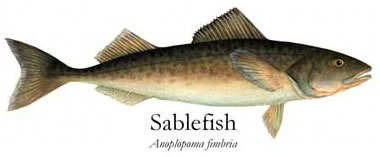Sablefishes—Family Anoplopomatidae
 Sablefish from Monterey Wharf #2
Sablefish from Monterey Wharf #2
Species: Anoplopoma fimbria (Pallas, 1814); from the Greek words anoplis (unarmed) and poma (operculum or gill cover), and the Latin word fimbria (fringe).
Alternate Names: Commercially called blackcod in Washington and butterfish in California. Other names include Alaska blackcod, coalfish, coal cod, candlefish, black candlefish, bluecod, deep sea trout, zipperfish, sable, skil-fish, skil, and skill. Called t’thémekwe by the Salish in British Columbia, sqel or skil by the Haida, and hádání by the Heiltsuk. Called bacalao negro in Mexico.
Identification: Elongate (cod-shaped) tapering to the tail. Two widly-spaced dorsal fins. Adult coloring is usually blackish-gray on the back and sides, gray to white below; young fish taken from piers are generally pale greenish-colored on top and sides fading to white.
 A small sablefish caught by polishfromthedeep from the Pismo Beach Pier
A small sablefish caught by polishfromthedeep from the Pismo Beach Pier
Size: To over 40 inches and 56 pounds although most caught off piers are young fish under a foot in length.
Range: Islas San Benito and Isla Cedros, central Baja, California to the Aleutian Islands and the Bering Sea south of St. Lawrence Island, Alaska. Also, Kamchatka, Russia, south to Hatsu Shima Island, southern Japan; usually in extremely deep water.
Habitat: Adult fish are caught in deep water, often over a thousand feet deep, and prefer areas of blue clay or mud. Young fish, to a foot long or so, are often found in fairly shallow areas. There is also a difference in habitat north and south; in southern California, sablefish are almost always found in deep-water areas, in northern California (Eureka north), sablefish will sometimes be in shallower water.
 An adult sablefish — From Alaska Seafoods
An adult sablefish — From Alaska Seafoods
Piers: Sablefish are never really common to California piers although piers adjacent to deep-water canyons may see a few each year. At times, vast schools will move in around piers and thousands of the fish will be caught. Best bets: Newport Pier, Balboa Pier, Redondo Beach Pier, and Monterey Wharf No. 2. In the far north, where sablefish become a more shallow-water fish, they will sometimes show up during the summer months in Humboldt Bay and a few will fall to anglers fishing from Eureka area piers. I have also seen small specimens taken from the Pismo Beach Pier and Capitola Wharf.
 A young sablefish from the Capitola Wharf
A young sablefish from the Capitola Wharf
Shoreline: Rarely taken by shore anglers.
Boats: Rarely taken by boaters in southern California although they’re commonly taken by rockcod anglers fishing in deep waters off Santa Cruz and Monterey.
Bait and Tackle: On piers a high/low rigging baited with strips of squid is the preferred method. On boats they are generally taken on typical rockcod tackle.
Food Value: Adult sablefish are one of the best tasting smoked fish. In fact, many people like the rich buttery flavor of sablefish better than salmon. Young sablefish are not quite as rich flavored or good, but they are still best smoked or broiled, methods which gives the flavor a chance to show itself. Do not, repeat, do not, pan-fry or deep-fry sablefish. The results will be an inferior piece of over oily meat.
 An early ad promoting the sale of sablefish
An early ad promoting the sale of sablefish
Comments: One of my favorite fish simply because it is an uncommon treat! Sablefish can live to about 55 years of age.
From the California Fish & Game — California Fish and Game, January 30, 1948 Volume 34, No. 1 —Notes 37
Sablefish Run at Monterey Bay
For the first time in history, sablefish (Anoplopoma fimbria) appeared in vast numbers in the vicinity of Monterey and were caught by the thousands from the municipal pier. The run was first discovered on the afternoon of July 11th; word of the bonanza spread rapidly, and the pier was soon crowded with anglers. Men, women, and children stood shoulder to shoulder, with a varied assortment of tackle, all hauling in fish as fast as they could throw in their lines. Boxes, sacks, five-gallon cans, and washtubs were rapidly filled with 12 to 20-inch fish. Slack periods occurred during the morning and again in the afternoons, but they were of short duration usually lasting only half an hour or less; then the fish would be back seemingly in greater numbers than before. Each day the pier would be jammed with crowds of from 2,000 to 3,500 fishermen and spectators, some having driven as far as 200 miles.
On July 26th, the run stopped as abruptly as it had begun, and although over 5,000 fishermen were on hand the next day, only a few fish were caught. During the 15 days of the run, the Bureau of Patrol Division of Fish and Game, estimated that over 110 tons had been landed.
— Keith W. Cox, Bureau of Marine Fisheries,
California Division of Fish and Game, September, 1947














